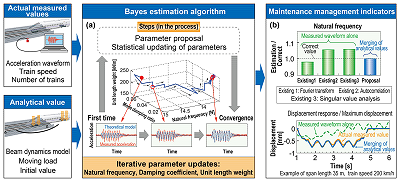25.Method for estimating bridge maintenance indicators by combining measured and analytical values
The increased running speed of trains and ageing of structures means that the safety of railway bridges needs to be assessed not only frequently but also with a high degree of accuracy. As a result, recent years have seen the generalization of acceleration-based ordinary mobile monitoring which can be carried out on a permanent basis. However, using only the existing wave-form processing from passing trains, it is difficult to accurately determine railway bridge parameters with the required level of precision when trains are passing, such as displacement, impact coefficients, natural frequency, damping constant, etc.
This research therefore developed a new method to accurately estimate bridge maintenance management indicators such as displacement and natural frequency, by combining values obtained through numerical analysis and actual waveforms measured during the passage of trains (Fig. 1 (a)).
In the present method, machine learning is applied in which a calculation correcting an input value into the analysis is statistically repeated comparing the actual measured values and analyzed values. Using this approach, it is possible to effectively estimate the maximum displacement and natural frequency required for maintenance of the railway bridge using the acceleration waveform from just one point. In order to balance the speed and stability of machine learning with the measured values especially, a Bayes estimation algorithm was developed to update parameters used based on statistical decision making for the iterative calculations. The accuracy of the proposed method was verified using numerical analysis and actual measured acceleration waveforms on the bridge when trains were passing. Results of the verification showed that it was possible to estimate the maximum displacement value, which had been difficult to obtain processing measured waveforms alone, within a 5% error margin, while the error margin in natural frequency and damping coefficient estimation was on average reduced to approximately 1 in 50 minutes compared to the existing method (Fig. 1 (b)).
Using the new method, it is possible to estimate the bridge's natural frequency and maximum displacement in approximately 5 minutes allowing on-site diagnosis of the bridge's soundness. Adapting the method to acceleration monitoring, will overcome the difficulties met with the existing method using just the acceleration waveform for ordinary observation, identification of weak bridges, and will allow prioritization of repairs and reinforcement.
Other Contents
- 24. Seismic resistance design method considering unsaturated condition of embankments
- 25.Method for estimating bridge maintenance indicators by combining measured and analytical values
- 26.Quantitative evaluation of the impact force on a bogie due to a wheel flat
- 27.Simulation of hot gas in tunnel fires
- 28.Development of work-place decision-making tasks to assess decision-making skills
- 29.Demonstration of vibration resistance and magnetomotive force of Yttrium-Barium-Copper-Oxide high temperature superconducting coil
- 24. Seismic resistance design method considering unsaturated condition of embankments
- 25.Method for estimating bridge maintenance indicators by combining measured and analytical values
- 26.Quantitative evaluation of the impact force on a bogie due to a wheel flat
- 27.Simulation of hot gas in tunnel fires
- 28.Development of work-place decision-making tasks to assess decision-making skills
- 29.Demonstration of vibration resistance and magnetomotive force of Yttrium-Barium-Copper-Oxide high temperature superconducting coil

